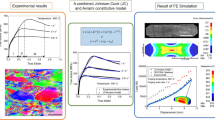Abstract
A numerical simulation of multi-stage heavy forging process using the finite element method (FEM) is presented in this study. The process of heavy forging is highly non-linear, where both microstructure and boundary conditions are altered by plastic deformation during forming. Therefore, it is necessary to understand the problem of plastic deformation in heavy forging. In order to investigate deformation behavior and microstructure evolution in heavy forging, a constitutive equation considering the effects of strain hardening and dynamic softening of the IN718 alloy is built. The constitutive equation and microstructure models are implemented into the finite element code to simulate deformation behavior and microstructure evolution in the rotary forging of heavy container head. As a result, variations of flow stress, effective strain, temperature, damage, and grain size in every stage are predicted.
Similar content being viewed by others
References
Hsiang SH (2004) Investigation of the influence of various process parameters on the radial forging processes by the finite element method (FEM). Int J Adv Manuf Technol 23:627–635
Ren YL (2000) The study for a new forging method of large container head. J Heavy Machinery 5:20–22
Jang YS (2000) Application of the finite element method to predict microstructure evolution in the hot forging of steel. J Mater Process Technol 101:85–94
Matjaz S, Janez S (2004) Computer-aided analysis of the forging process. Int J Adv Manuf Technol 23:161–168
Cho JR, Jeong HS (2005) Prediction of microstructural evolution and recrystallization behaviors of a hot working die steel by FEM. J Mater Process Technol 160:1–8
Cho JR (2001) A study on the hot-deformation behavior and dynamic recrystallization of Al-5 wt.%Mg alloy. J Mater Process Technol 118:356–361
Park JJ (2001) Prediction of the flow stress and grain size of steel during thick-plate rolling. J Mater Process Technol 113:581–586
Na YS (2003) Simulation of microstructures for Alloy 718 blade forging using 3D FEM simulator. J Mater Process Technol 141:337–342
Bontcheva N (2003) Microstructure evolution during metal forming processes. Comp Mater Sci 28:563–573
Ebrahimi R, Zahiri SH, Najafizadeh A (2006) Mathematical modeling of the stress-strain curve of Ti-IF steel at high temperature. J Mater Process Technol 171:301–305
Serajzadeh S, Taheri AK (2003) An investigate into the effect of carbon on the kinetics of dynamic restoration and flow behavior of carbon steels. Mech Mater 35:653–660
Huang C, Hawbolt EB (2001) Flow stress modeling and warm rolling simulation behavior of two Ti-Nb interstitial-free steels in the ferrite region. Acta Mater 49:1445–1452
Jeong HS, Cho JR (2005) Microstructure prediction of Nimonic 80A for large exhaust valve during hot closed die forging. J Mater Process Technol 162:504–511
Medeiros SC, Prasad YV (2000) Microstructural modeling of metadynamic recrystallization in hot working of IN718 superalloy. Mat Sci Eng A-Struct 293:198–207
Kong TF, Chan LC, Lee TC (2004) Prediction of a billet shape for axisymmetric warm forming using variational analysis. Key Eng Mater 274–276:733–738
Kong TF, Chan LC, Lee TC (2005) Numerical determination of blank shapes for warm forming non-axisymmetric components. J Mater Process Technol 167:472–479
Li WM, Liu GH, Liu ZB (1998) Key techniques for manufacturing dish-shaped forgings. Iron Steel 33:43–45
Zhang JM, Gao ZY (2000) Grain growth model of IN718 during holding period after hot deformation. Mat Sci Eng A-Struct 101:25–30
Author information
Authors and Affiliations
Corresponding author
Rights and permissions
About this article
Cite this article
Ma, Q., Lin, Zq. & Yu, Zq. Prediction of deformation behavior and microstructure evolution in heavy forging by FEM. Int J Adv Manuf Technol 40, 253–260 (2009). https://doi.org/10.1007/s00170-007-1337-9
Received:
Accepted:
Published:
Issue Date:
DOI: https://doi.org/10.1007/s00170-007-1337-9



